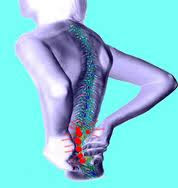A bulging disc is usually seen in the symptoms of pain, numbness, tingling, muscle weakness, muscle cramps, and discomfort are common. How, though, not the symptoms occur? When the disks are up, they had the nerve roots, spinal cord, and spinal cord may vary in other parts of the bulge. Pressure on the nerve roots or the spinal cord and a bulging disc or compressed when pain signals are sent to the end of the nerve receptors. The body of all the nerve endings of the spinal cord or nerve root from a bulging disc back pain from the back to detect because they can be transmitted anywhere in the body.
Why Do the Symptoms of a Bulging Disc Vary So Much?
The spinal column is comprised of 33 bones called vertebrae that span from the neck down to the tailbone. The vertebrae are divided into five sections, and each corresponds to a different section of the body. The neck is home to cervical vertebrae, the upper back is home to thoracic vertebrae, the lower back is home to lumbar vertebrae, the pelvic area is home to sacral vertebrae (which are fused), and just below the sacral vertebrae are the coccygeal vertebrae (or tailbone, which also is made up of fused vertebrae). Each section of the spinal column contains nerve roots that branch off the spinal cord and travel throughout specific areas of the body, and thus, bulging discs in different sections of the spine can cause symptoms in different bodily locations. For instance, a bulging disc between cervical vertebrae may send symptoms into the neck, arms, or fingers, while a bulging disc between two lower lumbar vertebrae may irritate the sciatic nerve and send sciatica symptoms of pain, numbness, or tingling into the buttocks, legs, or feet.
What is Sciatica and Can it Be Caused by a Bulging Disc?
Sciatica is not a medical condition, but is actually the set of symptoms that’s caused by the compression of the sciatic nerve. The symptoms of sciatica include pain, numbness, tingling, muscle weakness, muscle spasms, and other discomfort felt below the waist. Sciatica results when the sciatic nerve or a nerve near the sciatic nerve is irritated or compressed. A bulging disc is not the only cause of sciatica, but a disc bulge certainly can be a cause if it presses on the sciatic nerve.
The sciatic nerve rests along the lower lumbar and upper sacral vertebrae, and is the root of most sensory and muscular nerves in the lower body. The discs along the sciatic nerve receive more stress than other discs in the spine because they act as more of a focal point for supporting the weight and movement of the upper body. The additional stress these discs receive makes them more susceptible to bulging and other damage. When these particular discs bulge, it is very possible that they can press on and irritate the sciatic nerve, which can send the symptoms down into the lower body. The good news is that most people with sciatica are able to find sufficient relief from their symptoms with a combination of conservative (nonsurgical) treatments, though a proper diagnosis should be obtained from a doctor before any treatment regimen is started.
Why Do the Symptoms of a Bulging Disc Vary So Much?
The spinal column is comprised of 33 bones called vertebrae that span from the neck down to the tailbone. The vertebrae are divided into five sections, and each corresponds to a different section of the body. The neck is home to cervical vertebrae, the upper back is home to thoracic vertebrae, the lower back is home to lumbar vertebrae, the pelvic area is home to sacral vertebrae (which are fused), and just below the sacral vertebrae are the coccygeal vertebrae (or tailbone, which also is made up of fused vertebrae). Each section of the spinal column contains nerve roots that branch off the spinal cord and travel throughout specific areas of the body, and thus, bulging discs in different sections of the spine can cause symptoms in different bodily locations. For instance, a bulging disc between cervical vertebrae may send symptoms into the neck, arms, or fingers, while a bulging disc between two lower lumbar vertebrae may irritate the sciatic nerve and send sciatica symptoms of pain, numbness, or tingling into the buttocks, legs, or feet.
What is Sciatica and Can it Be Caused by a Bulging Disc?
Sciatica is not a medical condition, but is actually the set of symptoms that’s caused by the compression of the sciatic nerve. The symptoms of sciatica include pain, numbness, tingling, muscle weakness, muscle spasms, and other discomfort felt below the waist. Sciatica results when the sciatic nerve or a nerve near the sciatic nerve is irritated or compressed. A bulging disc is not the only cause of sciatica, but a disc bulge certainly can be a cause if it presses on the sciatic nerve.
The sciatic nerve rests along the lower lumbar and upper sacral vertebrae, and is the root of most sensory and muscular nerves in the lower body. The discs along the sciatic nerve receive more stress than other discs in the spine because they act as more of a focal point for supporting the weight and movement of the upper body. The additional stress these discs receive makes them more susceptible to bulging and other damage. When these particular discs bulge, it is very possible that they can press on and irritate the sciatic nerve, which can send the symptoms down into the lower body. The good news is that most people with sciatica are able to find sufficient relief from their symptoms with a combination of conservative (nonsurgical) treatments, though a proper diagnosis should be obtained from a doctor before any treatment regimen is started.

